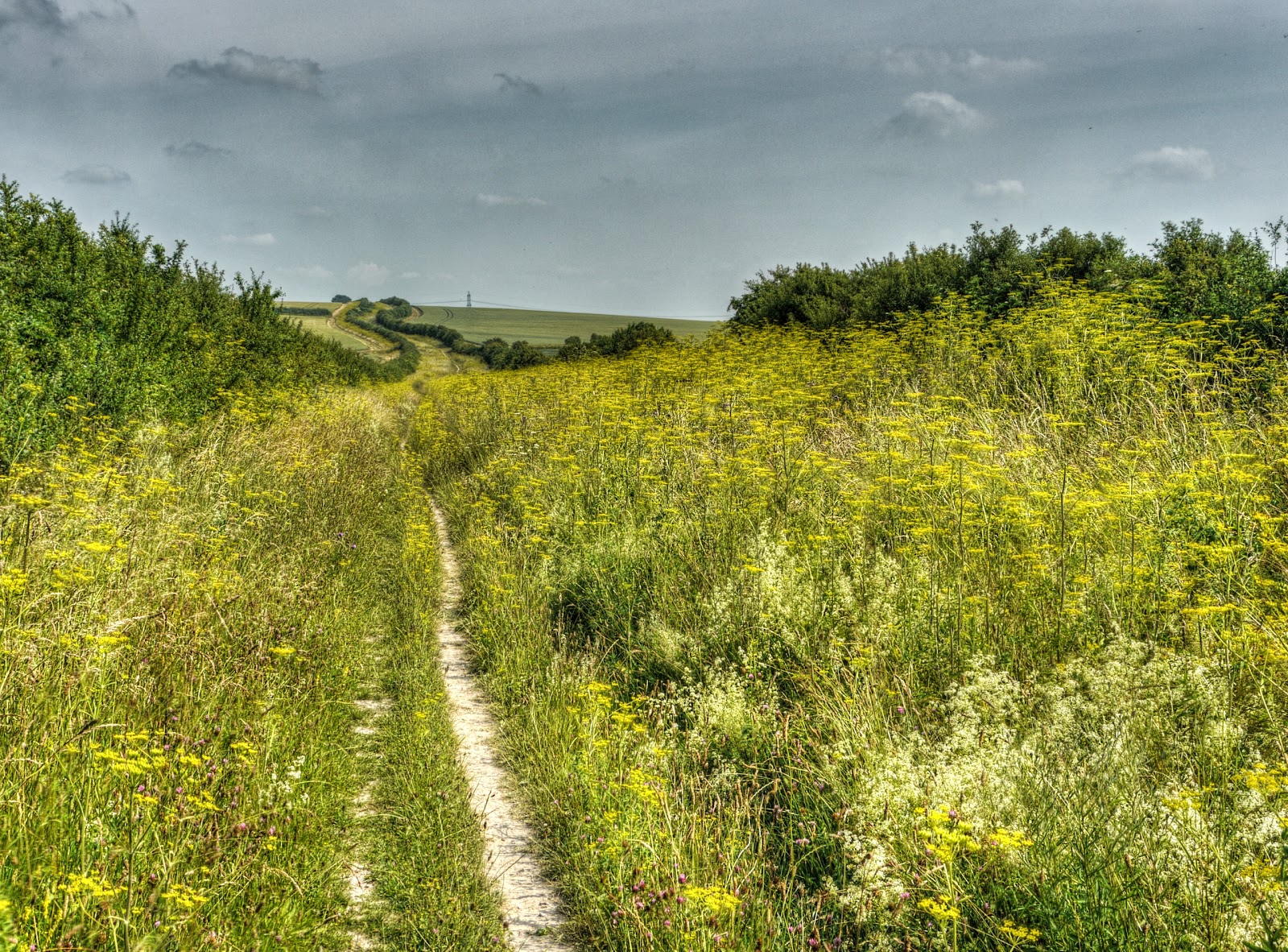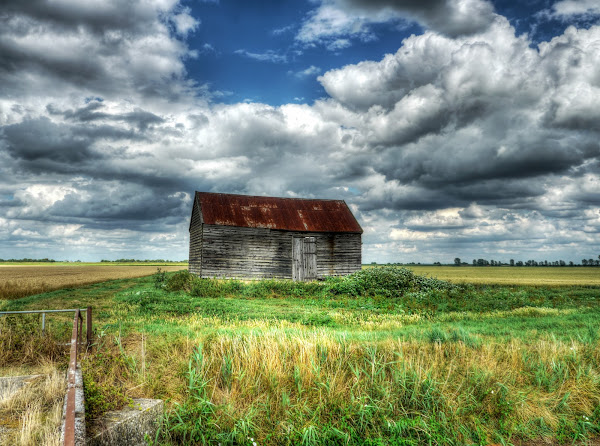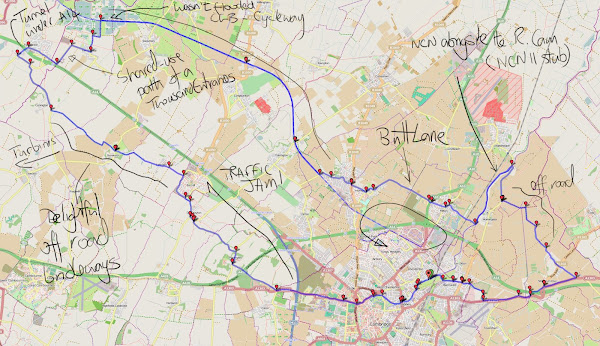Friday, 26th July 2013: For choice, when I go cycling I like go through the countryside, as rugged as possible and as far from motor vehicles and buildings as possible (and pylons). I also prefer not to have to travel a long way to get there. I am also not that keen on long hills – I prefer rolling countryside. I also accept that pretty much all of the countryside in the UK has been altered in some way or other.
For instance the Fens are not the swamps they used to be, the Lake District has been a “park” for a long time. I quite like cycling through farmed countryside and I really like cycling through woodland and grassland.
Of course my rules of cycling also come into play. I prefer to cycle a loop rather than there and back by the same route. If the route has some rugged aspects – e.g. corrugated mud tracks then I prefer them to be on the first half of the ride rather than on the way back. I also prefer to cycle out into the wind and back with the assistance of the wind.
Whilst I claim to be an all-weather cyclist I do find that I cycle more when the weather is sunny and warm. I claim it is because it makes the byways and bridleways easier and less muddy. (Or maybe I am just getting older!)
I also like to explore new routes, but here is one of my more “epic” routes around Cambridgeshire. It isn’t actually that far, just under 40miles (62Km), however quite a lot of it is away from road. It doesn’t reach great heights (40m) however you do find a little bit of rolling countryside around. What it does do is take you where cars (and other motor vehicles) can't go.
This route is a little longer than necessary and could easily be shortened. The best bits are heading out along the Cambridge Guided Busway Cycleway (CGBC) and coming back via the bridleways from Connington to Dry Drayton. The CGBC could do with a name really, cf. The Lodes Way. How about Slepe Way, the route runs out to St Ives which was called Slepe until 1,001/2.
However I wanted to re-visit the Butt Lane with its half-finished cycleway. At least the exercise of cycling along it would balance out the increase in blood pressure I suffer when I think about how dreadful the planning and implementation of that cycle route has been. (See Butt Lane – butt cycleway for my recent thoughts.)
So to start it off I enjoyed a pleasant detour out to Quy and then back through the fields to Horningsea and then up to Clayhithe and then back alongside the River Cam. The River Cam tow path forms an NCN11 stubs. It is a great leisure route to nowhere in that the cycle route stops at Waterbeach. If you want to take NCN11 to Ely then you have to use NCN51 – obvious isn’t it. The map shows a dotted line route – that is not some code for off-road that means it aint sorted yet and has it has been incomplete for a long time probably never will be.
The NCN 11 route alongside the Cam is very pleasant although the path is not very wide and it might be a bit trickier in the dark. I usually leave the tow path at Milton and then cut along to Butt Lane. This route was intended to be a way for schoolchildren to get from the village of Milton to Impington Village College. It caused an uproar because of the potential loss of the free school bus. (Normally free school buses are only supplied where the distance is greater than 3 miles, however this route (pre-cycle way) was deemed dangerous (I agree) and so the bus was free. Apparently over 200 pupils use it!
The plan was for a 2.5m wide cycle path with a 0.5m gap (as noted on A View from the Cycle Path). To be fair to the villagers in Milton although some concerns just seem to be about losing the free bus, others point out issues with the planned route. Although it does say they would only support the cycleway if there were cast iron assurances about the bus.
It seems that progress is being made – although I am not sure that progress is the right term. At the moment there is a purpose-built shared use path (oxymoron) that goes part way from Impington. There is also a footpath at the other end that passes the entrance to the P&R and the Recycling Centre.
Well I have some good news for the residents of Milton, I reckon their school bus service is safe. I don’t think that new bit of the shared-use path is safe, nor is it designed to DoT standards – Shared Use Routes for Pedestrians and Cyclists and Cycle Infrastructure Design. It is not wide enough, nor is there enough gap to the road. I think the road has a 50mph speed limit. Well Page 16 of the second document recommends a width of 5.05m where Buses/HGVs pass at 30mph.
The same document also talks about the dynamic width of a bicycle (Figure 2.2) and the distance a bicycle should be away from kerbs (0.5m) and continuous features (1m)/ They cite walls and railings, but I reckon hedges fit that bill as well.
This is where Butt Lane passes the Business Park. I would hope that the priority would lie with the cycle path. Particularly as the young teenagers are undergoing further brain development and are prone to taking more risks. You will also note that the path is right next to the road. Now my handlebars are 65cm wide – which means my handlebars would have a significant overhang on the road if I were to cycle close to the kerb.
Butt Lane – Butt Cycleway
Here is the map of my route and here is the Bike Route Toaster Link.
A Cambridge – Connington Loop
Here is the old stretch of the shared-use path. I must remember to take a tape-measure – it doesn’t look very wide. Although there is a wider gap to the road. Unfortunately this bit of the path is booby-trapped. The path is right next to the hedge and brambles hang over. Perhaps cyclists will have to wear safety goggles when they cycle so they don’t get their eyes scratched out.
I once had to get into London early and so cycled to the station when it was still dark. My front light was set to illuminate the road/path surface ahead and I was raked by brambles. I got a strange look when I bought my ticket – when I popped into the gents I could see why. My face had streaks of blood.
Butt Lane – Butt Cycleway – Butt Brambles
The trouble is shared-use paths suffer from lack of maintenance (and poor design) because pedestrians are also seen as second class citizens. Having passed through Histon I reached Park Lane. This is the shared use bit just on the outskirts of the village. There are protruding brambles and overhanging branches. The path is very narrow – still at least there is a wider gap to the road.
Park lane – Shared Use Path, Histon
After that it was a pleasure to reach the CGBC or Slepe Cycleway. Alright there are buses that go by, but they aren’t that noisy and they do whizz by pretty quickly. At the moment, after Histon the route passes through farmers’ fields and the Fen Drayton RSPB Reserve. Mind you in the mindless rush to build more houses in the area (Bourn) we do have a pending village/town – Northstowe which will take away some of that view.
The strange thing is that we are told that we need lots and lots of houses – but despite Northstowe planning submissions being made in 2007, eight years later nothing much has happened. Why? well perhaps because the developers didn’t think they could sell the houses. The lack of progress on the A14 road improvement scheme was used as a an excuse reason as well.
Potatoes growing alongside the CGB Cycleway
Looking at the cycleway alongside the CGB it looks pretty good eh – wide, smooth tarmac, solar powered lights along each side. Mind you the original scheme did not include a tarmac surface beyond Swavesey. Fortunately a charity stepped in with £150,000. It also still floods quite a lot at the St Ives end. The cycleway not the busway.
So even in a cycling city cyclists get the leftovers. Mind you the development was fraught and there is still a dispute between the County Council and the Contractors. The good news is that the Busway seems to be doing well with the busway carrying over 3m passengers in its second year of operation. (>8,200 per day, 7 days a week.).
Cambridgeshire Guided Busway – Cycleway
I like the CGBC as it is a pleasant and fast route to other places and it is fairly long and not interrupted by junctions too often. From Milton Road, Cambridge to Harrison Way, St Ives the cycleway is a little under 20Km (12 miles) and around 6 junctions.
I turned off before St Ives at the Fen Drayton Lakes, down Holywell Ferry Road and through Fen Drayton. Although it is called a road it is really a pot-holed gravel track. After Fen Drayton you can choose this bit of shared-used pavement alongside Mill Road. Pavement with paint really and too much of it. This stretch of path has 12 give-ways along it. It is 0.88Km or a little over half a mile. That is pretty awful. What is the legal position for pedestrians do they have to give way? Check out Highway Code rule 206 (it has many bullet points this is one.)
Drive carefully and slowly when
- needing to cross a pavement or cycle track; for example, to reach or leave a driveway. Give way to pedestrians and cyclists on the pavement
Well that clears that up – not.
Shared-use path – 12 give-ways in half a mile – Mill Road, Fen Drayton
After negotiating the speed bumps along the High St in Fenstanton you have to turn left down Hilton Road. This road only works as Hilton Road for pedestrians, cyclists and horse riders since there appear to be bridleway rights. Mind you you have to go down a narrow tunnel under the A14 and negotiate some pretty tight bends. I reckon you’d have to get of the horse. Then you reach Hilton Road, although on Streetmap (25k) it has been renamed Hilton Road!
Then there is a pleasant run down to a bridleway of the Elsworth Road. Then, until you get to Dry Drayton it is mainly fields. It is not totally obvious quite where the path is – although there are gates along the way. The second field along (I think) I cycled through a field of sheep. I did my best not to disturb them and they didn’t seem to bothered by me bumping along.
Spot the bridleway in this field of sheep near Connington
There weren’t any cows in the field I was in, although I could hear some nearby. A little more care is needed then – but I have never really had any problems. I have been chased many times by dogs though! Talking about cows a man was trampled by cows near St Neots and is seriously ill in hospital (Addenbrookes) – that is quite close by.
Although the bridleway runs in parallel with the A14 you don’t really hear much. Some of the fields have crops growing in them – there are wide field margins though. This bit of the countryside is also a bit more rolling – hum, be careful what you wish for. Climbing on grass can be a bit more energy sapping.
Bridleway between Connington and Boxworth
Alright the hills are not that big – it gets up around 40m above sea level.
Bridleway between Connington and Boxworth
Once you are there the views are good.
Bridleway between Connington and Boxworth
It was a Friday and it looked like lots of motorists had flooded onto the A14. According to the OSM map this bit was closer to 50m above sea level. It is where the bridleway jinks. If you zoom in you can see in the near ground the Boxworth Lorry park and more distantly a church spire in Fen Drayton (St Mary) and a church tower (St Andrews) in Swavesey. According to the Cambridge News there is an issue with the ”sex trade” at the Lorry Stop.
View from the Bridleway between Connington and Boxworth
The same aspect, but much less zoom.
The Bridleway between Connington and Boxworth
Looking back the way I had come – alright I will come clean – it was a fair haul on the soft grass and I needed a breather.
The Bridleway between Connington and Boxworth
Looking back I noticed some wind turbines – these things seem to be popping up all over the place. If you look at the picture closely (or enlarged) you can see how the heat haze has made the columns look wiggly – either that or they are a new type of design.
The OS and OSM maps don’t actually show this development. I think that it is Cotton Farm according to this map, near to Gravely. It is shown as under construction. It appears on this link – Cotton Farm Action Group with 8 turbines so it matches the picture. The Google Satellite picture shows what looks like an old airfield. It is producing energy. Why is it Wind Farms quote the number of homes – in this case approx. 10,000 homes.
The Website does mention it is on the site of a World War II airfield – RAF Gravely – some pictures.
Cotton Farm Wind Farm – (on the site of RAF Gravely
You roll down and the up from Boxworth to Lolworth and then I take what is strictly a footpath from Lolworth to Bar Hill. Yes the track rolls down – then you have to roll up around Bar Hill. There were a couple of inquisitive, small and yappy dogs – more inquisitive than anything really.
I suppose I could have cycled along the A14 and maybe got some words of advice from the Police like this Rickshaw cyclist, they did point out he was not committing an offence.
Footpath from Lolworth to Bar Hill
After that I climbed up again to Dry Drayton squeezing through the various Gandalf Gates (“You shall not pass”) that block the way for all but thin travellers. Then it was rolling road into Cambridge Although I did stop to take a picture of the bit where the M11 meets the A14 – lots of cars with one person in them!
Friday afternoon queuing – approaching the Girton Interchange
So there you are – I rather like the ride – when the going is good – you cover some distance, see some countryside and climb a few small hills to boot and mainly not-road


















































